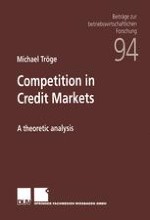2001 | OriginalPaper | Buchkapitel
Usury and Credit Rationing
verfasst von : Michael Tröge
Erschienen in: Competition in Credit Markets
Verlag: Deutscher Universitätsverlag
Enthalten in: Professional Book Archive
Aktivieren Sie unsere intelligente Suche, um passende Fachinhalte oder Patente zu finden.
Wählen Sie Textabschnitte aus um mit Künstlicher Intelligenz passenden Patente zu finden. powered by
Markieren Sie Textabschnitte, um KI-gestützt weitere passende Inhalte zu finden. powered by
The simple model of monitored finance which is constructed in the first part of this chapter helps to explain several features of a bank-firm relationship. However, the principal intention of this chapter is to give a new explanation for credit rationing by banks. The attitude of hanks with respect to credit risk has puzzled economists for a long time The interest rates banks quote do not differ very much among firms of different riskiness. For example Machauer and Weber (1998) analyze the dependence of interest rates on a bank’s own internal rating of borrowers. In their sample, the average interest rate difference between borrowers in the hest and the worst of five risk classes is only 1.2%. Given that t ire best class is defined as “good or very good creditors” whereas the worst. class consists of borrowers which are “very much in danger of default” these interest differences are much smaller than the interest rate spreads on corporate bonds of comparable r ratings. In addition, the results of Petersen and Rajah (1994) or Blackwell and Winter (1997) seem to indicate that the variations of the interest rate can rattier be explained with differences in bargaining power or credit market competition than with the riskiness of a loan.
